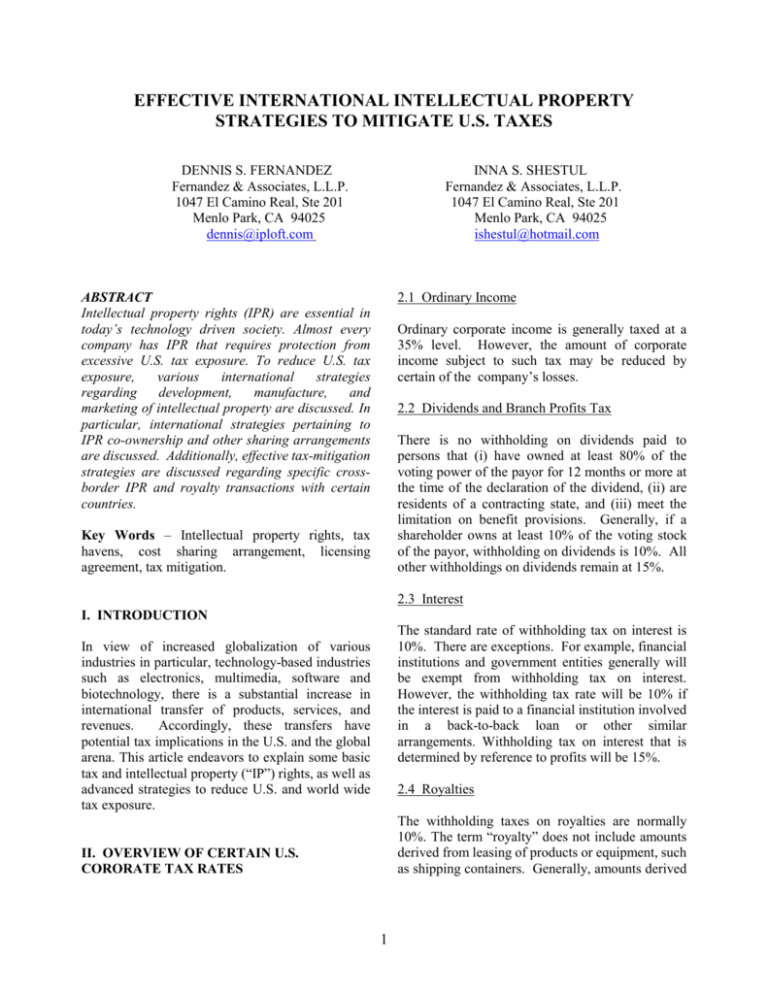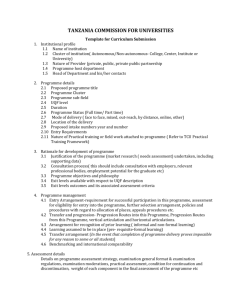Effective International Intellectual Property Strategies To Mitigate US
advertisement

EFFECTIVE INTERNATIONAL INTELLECTUAL PROPERTY STRATEGIES TO MITIGATE U.S. TAXES DENNIS S. FERNANDEZ Fernandez & Associates, L.L.P. 1047 El Camino Real, Ste 201 Menlo Park, CA 94025 dennis@iploft.com INNA S. SHESTUL Fernandez & Associates, L.L.P. 1047 El Camino Real, Ste 201 Menlo Park, CA 94025 ishestul@hotmail.com 2.1 Ordinary Income ABSTRACT Intellectual property rights (IPR) are essential in today’s technology driven society. Almost every company has IPR that requires protection from excessive U.S. tax exposure. To reduce U.S. tax exposure, various international strategies regarding development, manufacture, and marketing of intellectual property are discussed. In particular, international strategies pertaining to IPR co-ownership and other sharing arrangements are discussed. Additionally, effective tax-mitigation strategies are discussed regarding specific crossborder IPR and royalty transactions with certain countries. Ordinary corporate income is generally taxed at a 35% level. However, the amount of corporate income subject to such tax may be reduced by certain of the company’s losses. 2.2 Dividends and Branch Profits Tax There is no withholding on dividends paid to persons that (i) have owned at least 80% of the voting power of the payor for 12 months or more at the time of the declaration of the dividend, (ii) are residents of a contracting state, and (iii) meet the limitation on benefit provisions. Generally, if a shareholder owns at least 10% of the voting stock of the payor, withholding on dividends is 10%. All other withholdings on dividends remain at 15%. Key Words – Intellectual property rights, tax havens, cost sharing arrangement, licensing agreement, tax mitigation. 2.3 Interest I. INTRODUCTION The standard rate of withholding tax on interest is 10%. There are exceptions. For example, financial institutions and government entities generally will be exempt from withholding tax on interest. However, the withholding tax rate will be 10% if the interest is paid to a financial institution involved in a back-to-back loan or other similar arrangements. Withholding tax on interest that is determined by reference to profits will be 15%. In view of increased globalization of various industries in particular, technology-based industries such as electronics, multimedia, software and biotechnology, there is a substantial increase in international transfer of products, services, and revenues. Accordingly, these transfers have potential tax implications in the U.S. and the global arena. This article endeavors to explain some basic tax and intellectual property (“IP”) rights, as well as advanced strategies to reduce U.S. and world wide tax exposure. 2.4 Royalties The withholding taxes on royalties are normally 10%. The term “royalty” does not include amounts derived from leasing of products or equipment, such as shipping containers. Generally, amounts derived II. OVERVIEW OF CERTAIN U.S. CORORATE TAX RATES 1 from equipment or product leasing are categorized as business profits. Another factor would be local issues: • 2.5 Capital Gains • • The withholding rate for a company’s capital gains depends solely on the duration of the property or stock held by the company and usually varies from 20% to 10% and could be reduced by the company’s capital losses, subject to certain limitations. However, on the global level, when a company has a foreign subsidiary, the tax on capital gains may be covered by a treaty between the U.S. and the country in which the subsidiary is domiciled. In this instance, any gain will generally constitute foreign-sourced income for the purposes of computing the foreign tax credit limitation in the U.S. Such treatment reduces the risk of double taxation for shareholders that are U.S. taxpayers. Most forms of capital gain are taxed in the country in which the property is located. In the case of capital gain from the disposition of shares in a corporation, it is taxed in the issuer’s country of domicile. As a third factor, a U.S. company must address its clients’ planned operations: • • • • • • • • Before embarking on overseas operations, such as to accomplish things like product manufacturing, marketing, sales or support services, there are several factors a U.S. company must consider. One factor is its U.S. tax position on the following: • • Who owns IP that will be used in business and where will future research and development activities (“R&D”) take place? Where will manufacturing take place? How will sales be generated? How will future operations be funded? How close must inventories be to customers? A fourth factor a U.S. company must consider when expanding into foreign markets would be the form of entity that will house its foreign operations. Foreign entities could be of the following categories: III. EXPANDING INTO FOREIGN MARKETS: THRESHOLD ISSUES • What filing obligations are imposed in the local country? What customs duties could be applicable? What local taxes are payable when and if a company withdraws from the local country (sale, liquidation, etc.)? • What type of U.S. shareholder it is: - Corporation (§901 and 902 credits are available) - Individuals (§901 credits only) - S corporations (§901 credits only) Foreign branch Wholly-owned foreign subsidiary Hybrid entity (i.e. foreign subsidiary plus check the box election (equivalent to the U.S. LLC)) Joint venture: - Foreign Subsidiary - Foreign Partnership - Hybrid Entity Fifth, it is important the foreign entity be established with a clear understanding its parent company’s overall business objectives related to establishing the foreign presence: Is it a sales office? a marketing/sales support office? customer service center? repair center? shared service center? What is the U.S. Foreign Tax Credit (FTC) position of U.S. shareholder: - Ability to absorb foreign source losses - Excess FTCs Finally, a U.S. parent company must consider specific local country business, legal, economic and cultural factors such as the following: What is the impact of projected results under various assumptions (profits or losses)on the U.S. tax position? 2 - - Do local customers prefer to deal with a local company rather than a branch of a foreign company? Is a local legal entity required for legal reasons (e.g. regulatory license of an investment advisor must be held by a legal entity)? Is local legal liability protection desirable? Some disadvantages could be: • Local incentives may only be available to subsidiaries • Consolidation of local country results IV. INBOUND VERSUS OUTBOUND TRANSACTION AND ROYALTY STREAMS If a U.S. company chooses to establish a foreign subsidiary, the following structure and legal characteristics would generally result in a tax efficient outcome: When a multinational enterprise (MNE) group is addressing the development of a new intangible, the subject of determining which member of the group should be the developer or owner of the property often arises. Depending on how the rights and obligations to the parties are structured, the arrangement could constitute a legal relationship such as: U.S. Parent Company • • • • U.S. Subsidiary Cost-sharing arrangement Provision of technical services for a fee License or sale of existing technology Partnership 4.1 Cost-Sharing Arrangement Foreign Subsidiary A cost-sharing arrangement is an agreement under which the parties agree to share the costs of the development of one or more intangibles in proportion to reasonably anticipated benefits from their individual exploitation of the interests in the intangibles assigned to them under the arrangement [1]. Under a valid cost-sharing agreement, both a domestic parent and its foreign subsidiary (for example) will incur R&D expenses and both will deduct them to reduce taxable income. However, if the foreign subsidiary is located in one of the tax havens like Bermuda* or the Cayman Islands* where the tax rate is zero, the deduction will not arise for the foreign subsidiary. Customers -sales -customer service -technical support -etc. • • • • • • Formal incorporation of the legal entity Minimum capital requirements Formal transfer of assets to legal entity Regular board and shareholder meetings Statutory audit requirements Formal liquidation requirements A cost sharing arrangement involves the joint development and use of intangible property through the agreement by more than one controlled or uncontrolled party to share the costs of the project. However, a different case occurs if an arrangement specifies that one party will provide the research and development (R&D) services for another party, and that the second party will be responsible for the costs and risks and therefore The advantages of forming a foreign subsidiary are: • • • • Isolation of economic activities of the foreign operation in a distinct legal entity Local country legal liability protection Profits earned abroad generally not taxable in the U.S. until repatriated Capital gains on sale of shares generally exempt from local country tax 3 entitled to the project’s benefits. Instead of being a cost-sharing arrangement, it would be a services arrangement under which one party is a service provider and the other is the owner (developer) of the technology. 4.4 How It Works • When a U.S. parent company files a patent with the USPTO, it is advisable that the filing takes place under the Patent Corporate Treaty (PCT), where all the listed countries, including the U.S., are designated. • The next step is that the U.S. parent company sets up an offshore holding company (Foreign Sub. 1) located in a lowtax jurisdiction, such as Bermuda*. • Then, an offshore unit buys stake in the parent’s existing patent before it starts to generate any value. This patent is developed jointly by the parent company and Foreign Sub. 1 under a cost sharing arrangement. • Then, the offshore unit licenses intangibles, such as the above-mentioned patent, to Foreign Sub. 2, typically in a third country such as Ireland*, which then collects royalties from foreign subsidiaries (3,4,5) that sell the parent company’s products to foreign customers. • Finally, royalties are returned by Foreign Sub. 2 to Foreign Sub. 1, which forwards one portion back to the U.S. parent and keeps its own portion offshore, which is not subject to U.S. taxes. • The benefit of this sort of transaction is the deferral of the transfer of income to a time that is tax efficient for the U.S. parent company. • Please refer to chart below: 4.2 License or Sale of Existing Technology If the terms of an arrangement are, in effect, that one party agrees to be responsible for the costs and risks of the project and, at the same time, to get a full deduction of incurred R&D expenses of the developed product, but another party agrees to acquire certain rights in the intangible when the development project is complete, the arrangement for the development of technology could be an advance license or sale. The other party might also agree to make an advance payment to the developer, and payment might be viewed as an advance royalty or purchase price. The form of consideration is nondeterminative of whether the arrangement is a license agreement or not. If a transferee of an intangible pays a nominal or no consideration and the transferor has retained a substantial interest in the property, the arm’s length consideration shall be in the form of a royalty, unless a different form is demonstrably more appropriate [2]. 4.3 Partnership A partnership arrangement (also called a joint venture arrangement) typically involves a joint undertaking to conduct certain joint business activities. The terms of the respective rights and obligations of the partners, or ventures, are established in a detailed partnership agreement. This is a much less inclusive undertaking than a cost-sharing arrangement, in which participants typically would come together solely for the purpose of jointly developing intangible property, not for jointly exploiting the property once it is developed or conducting any actual business operations. In this sense, a cost- sharing agreement is merely a contract to develop an intangible that each participant will have the right to exploit in its respective business operations. Under a partnership or joint venture arrangement, however, a separate legal entity is established to conduct the jointly owned enterprise [3]. 4 U.S. Company PCT filing of the patent designating U.S. 4.5 Tax Havens Comparison Before starting to license intangibles to foreign customers, a U.S. parent company needs to decide where to park its IP, possibly tax free. Buy-In Payments Intangibles (Patent) Cost-Sharing Before patent Arrangement starts Generating value Tax Havens Form Caymans * Bermuda * Company Unit Trust Company Unit Ltd, Partnership Trust Ltd, Partnership Type of Fund Open-End, Closed- Open-End, ClosedEnd Class, Hybrid End Scheme 1 week Memorandum 3 to 5 weeks Formation Prospectus, Time/Docume and Articles of Association or Deed Memorandum of ntation Association or of Trust license to conduct business in Deed of Trust and the Caymans unless Application (1) minimum $33,000 Document equity interest; or (2) fund listed on approved stock exchange Shareholder No shareholder Annual Meetings meeting required, need not meeting Required be in Bermuda Foreign Sub.1 low-tax jurisdiction License intangibles Royalties Foreign Sub. 2 Foreign Subs. 3, 4, 5 Foreign Customers 5 Taxation No individual income, corporate, capital gains, or transfer tax payable by funds or shareholders, no tax treaties No individual income, corporate, profit, withholding, capital gains, estate, duty, or inheritance tax payable by funds or shareholders, no tax treaties Exchange information between Foreign Authorities Mutual legal assistance treaty with the U.S. provides for cooperation with regard to narcotic or fraud matters USA – Bermuda* Tax Convention Act provides for mutual assistance in tax fraud matters, No other applicable treaties VI. REFERENCES Tax Havens Form Ireland * Luxembourg * Company Unit Trust Fixed Capital Ltd., Partnership Company Variable Capital Unit Trust Ltd., Partnership Type of Fund UCITS Non-UCITS UCITS NonUCITS (including (including closedend, venture capital, closed-end, and real estate funds); venture capital, and real estates Professional funds) Investors Funds; Qualifying Professional Investors Funds 3 to 5 months 2 to 3 months Formation Prospectus and Time/Docume Memorandum and Articles of Articles of ntation Association or Deed Incorporation or Deed of Trust of Trust Shareholder meeting Required Annual Meeting Must be in Ireland Annual meeting must be in Luxembourg Taxation Special tax zone exempts funds and shareholders from income and capital gains tax. Tax benefits available for management company. Extensive tax treaty network Exchange information between Foreign Authorities Under the Official Secrets Act, must maintain confidentiality, subject to limited circumstances No income, capital gains, withholding, or dividends tax on funds of nonresident shareholder. Tax benefits available for management company. Extensive tax treaty network Banking secrecy set by statute [1] See Treas. Reg. 1.482-7(a)1 [2] See Treas. Reg. 1.482-4(f)(1) [3] See Int’l Trans. Pricing O.E.C.D. guidelines 6.01 V. CONCLUSION * These are mere examples or suggestions. While they have served the desired purposes in the past, the authors do not necessarily suggest or advise that these particular countries continue to provide such means. The reader is cautioned to do due diligence with regard to the current conditions of the tax haven under considerations. Companies that adopt this strategy typically cut their taxes by between 5% and 20%. This effective tax-planning strategy has been employed by numerous Fortune 500 companies. 6



